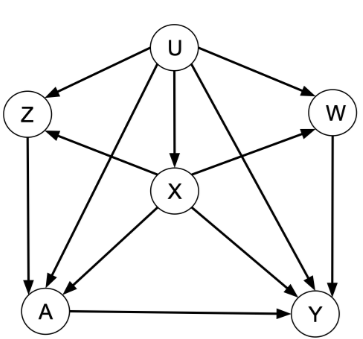links
papers
- Liu et al is a practical guide to proximal causal inference using regressions [the semiparametric analogue is cursed]. Basic idea is, given (outcome, binary treatment, covariates, instrument/treatment proxy, outcome proxy, unobserved confounder), and the pentagram DAG below holding, we can estimate the following regressions.
Since cannot affect , the conditional expectation , and so fitted value from this regression is a noisy estimate of the unobserved confounder . Then, run
where the last term is the fitted value from the first regression. This is standard 2SLS but the instrumented variable is not the treatment but the outcome proxy . CHKSS note that this approach goes back to technical instruments due to Griliches and Chamberlain.

-
Huang and McCartan provides a general framework for sensitivity analysis that encompasses selection on observables, IV, and the above proximal approach. They extend the now seminal Cinelli/Hazlett setup for reasoning about omitted-variables-bias to additional designs, and propose extensions to the partial-R2 plots popularized by CH for new designs (the turn out to be considerably more complicated and do not stay in the positive quadrant anymore).
-
Ramdas and Wang monograph on e-values, the canadian cousin of the p-value.
-
Hojbjerre-Frandsen and Schuler show that prognostic score adjustment is TMLE in RCTs; specifically, the residual between the difference in means and imputation functions can be used as a clever covariate.
-
Papadogeorgou et al review of bipartite experiments. Related: JP Abadie’s CODE keynote from a couple of years ago is also an excellent introduction to bipartite experiments (and experimentation in interference settings in general).
code, music
-
mlx-omni-server - local inference framework powered by MLX with OAI-compatible endpoints. Looking forward to trying this with logprobs [which are still not possible with ollama, for reasons I don’t understand].
-
using adelie a bunch recently. It is extremely fast and efficient, esp relative to existing penalized regression libraries
-
Nate Smith’s Pocket Change has been on heavy rotation.
-
Benn Jordan’s “I saved a PNG image to a bird” is an instant classic. I’ve long been a fan of his music, and his graduation into garage science legend is welcome. He also got me into midinous, which is factorio for musicians.
-
Parcels’ berlin recording has also been on heavy rotation. Extremely tight aussie electro-pop band where each member’s aesthetic choices harken to a different decade in pop music [Crommelin could have been in the beatles, Swain could have been in the backstreet boys, Hill could have been in ELP, and Hetherington is the spitting-image of my advisor].
self-promotion
-
If you’re at KDD, go see my coauthor Winston present our residuals on residuals paper at KDD workshop on Causal Inference and ML in practice. The most recent draft is here.
-
due to [jax-metal] being finicky on m-chips, I translated my jaxonometrics library into pytorch, which is more mature and has better hardware support for both its home domain of CUDA and apple GPUs. torchonometrics is a minimalist econometrics library that implements linear regression, MLE, and GMM in a flexible, GPU-first manner. Should already be fairly stable and usable; will add more concrete implementations of common estimators in the future.
-
My paper with Mac Lockhart, Yiqing Xu, and Ziwen Zu on the use of instrumental variables in political science won the 2025 Editors’ Choice Award from the Society for Political Methodology at Polmeth 2025. A large part of this paper is didactic in nature and I’m glad it is finding an audience. The accompanying ivdiag package implements all of the methods we discuss in the paper; I’m especially partial to the Zero-First-Stage Subsample method paired with the plausibly-exogenous augmented IV estimator, which was unfortunately relelgated to appendix A3.
-
pypi update to pyensmallen to make JAX truly optional [previous partial import was buggy in venvs w/o jax], which fixes installation issues on macos.